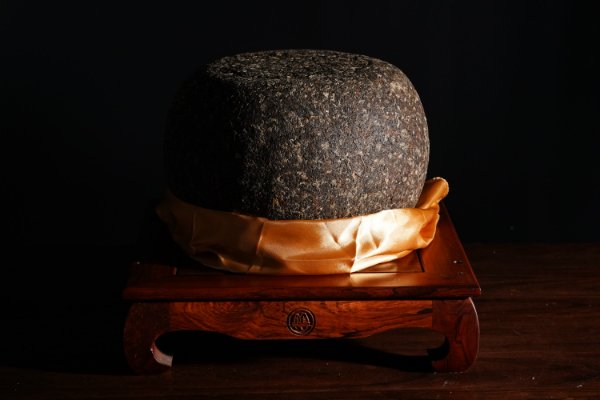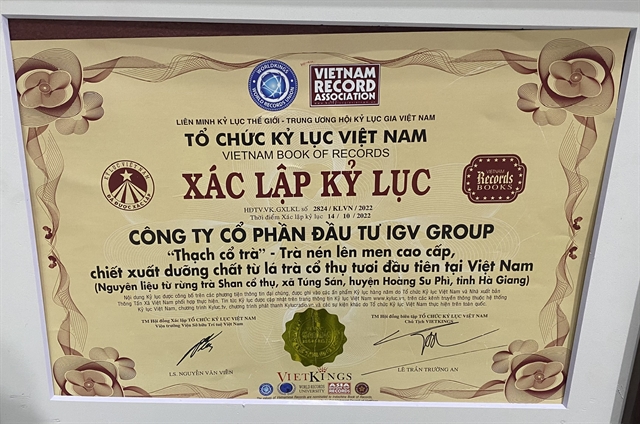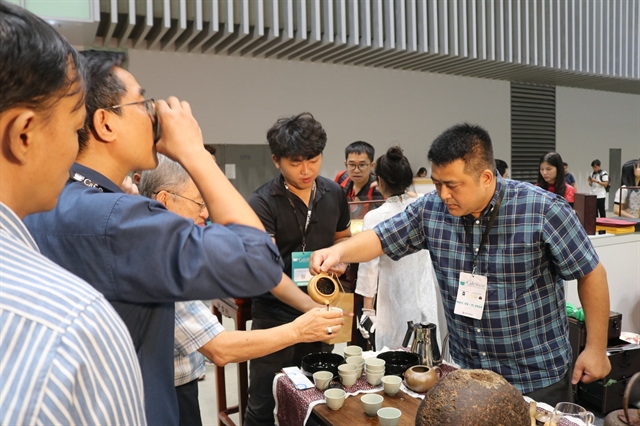 Sunday/Weekend
Sunday/Weekend

 |
| “Thạch cổ trà”, which is a black tea block with a diameter of 40 cm and weighing around 16kg, is a combination of six different types of tea including green tea, yellow tea, white tea, Oolong tea, red tea, and black tea. – Photo courtesy of IGV JSC |
by Hồng Linh
“Thạch cổ trà" by IGV JSC (in Hà Đông District, Hà Nội City), is a unique fermented tea product of Việt Nam that can maintain its flavour for centuries.
“Thạch cổ trà”, which is a black tea block with a diameter of 40 cm and weighing around 16kg, is a combination of six different types of tea including green tea, yellow tea, white tea, Oolong tea, red tea, and black tea.
The name "Thạch cổ trà" signifies tea grown on rocks, or can be referred to as rocked drum tea based on Hán (Han Chinese script) and Nôm characters.
It is inspired by the ancient indigenous tea trees in the sourcing area of this product variety in Tùng Sán Commune, Hoàng Su Phì District, Hà Giang Province.
This area is located at an altitude of 1200m - 1800m between the Tây Côn Lĩnh and Chiêu Lầu Thi mountain ranges, with temperatures often below 5 degrees Celsius compared to the surrounding regions.
Here, there exist many ancient tea trees with life spans ranging from 400 to 1,000 years, with their roots deeply entrenched in rocky crevices.
The block is crafted using a combination of traditional and modern methods, drawing inspiration from the ancient Phổ Nhĩ technique originating from China and the Oolong tea-making methods from Taiwan (China).
Nguyễn Đăng Bền, General Director of IGV JSC, said that to preserve the sourcing area, they would only harvest the tea leaves in two sessions, spring and autumn.
“The optimal time to harvest young buds is typically around two weeks after the start of autumn leaf picking, which helps ensure the highest quality and a balanced blend of nutrients and flavour,” Bền said.
The harvesting method of tea is a significant concern as it aids in preserving the health of the tea plant and ensuring the quality of the harvested leaves, according to Bền.
Raw tea leaves are harvested using the "one bud, two leaves" technique, wherein two young leaves along with the bud are plucked from the branches of the tea plant, while one leaf is left behind to allow the plant to continue growing and producing new leaves.
Freshly harvested tea leaves will be withered for half a day. If it is raining or the air humidity is high at that time, the withering time will be extended.
During withering, the tea will be manually stirred every 30 minutes to prevent moisture from being retained in the leaves, thereby avoiding the tea from becoming sour. The heat from the hands helps enhance the flavour of the tea.
After that, the tea leaves undergo a rolling and compressing process into a block, followed by drying and slow roasting. Each block consists of multiple layers of tea leaves, with each layer undergoing a unique degree of fermentation. The entire process takes around 3,000 hours to complete.
He said that producing a 16kg tea block requires up to 100kg of rare tea leaves and the production quantity is limited to around 20 tea blocks per year.
“This type of tea was only commercialised two years ago, and it's been purchased not only for consumption but also for collecting and investing purposes. The tea blocks increase in value over time, with an appreciation rate ranging from 15 per cent to 20 per cent per year,"
He said “The tea will be supported for preservation for 10 years, and afterwards, we offer cold storage services that can extend preservation for up to 100 years.”
Bền said the idea for this type of tea originated from the event "Hundred-year Tribute Tea Returns Home, Good Expectations for Pu'er," which took place on March 19, 2007, in Xuanwu District, Beijing, China.
At this event, a block of two and a half kilos of Pu'er Tea was exhibited from a storage house of the Forbidden City in Beijing in the 1960s and had been aged for 150 years. For the first time, people tried a cup of tea made from 150-year-old tea, and the flavour still persisted over time.
“It made me wonder, with our various sources of indigenous tea trees, if we could make a better tea product than China. I considered this a lot, making a unique brand of a Việt Nam product. So after six years of research and development we introduced our product, Thạch cổ trà,” he said.
 |
| A record issued by the Việt Nam Record Association certifying "Thạch Cổ Trà" as Việt Nam's first premium fermented tea with extracted nutrients from the fresh ancient tea leaves.- VNS Photo Hồng Linh |
The product sets a Vietnamese record as a premium fermented tea, extracting nutrients from the fresh ancient tea leaves for the first time in Việt Nam.
It was first introduced into HCM City at The Vietnam International Café Show and Tea Show 2024, held at District 7's Saigon Exhibition and Convention Centre from May 9 to 11.
 |
| "Thạch Cổ Trà" tea product introduced at The Vietnam International Café Show and Tea Show 2024, held at District 7's Saigon Exhibition and Convention Centre. – VNS Photo Hồng Linh |
This specialised exhibition, featuring coffee, food, beverage products, and related technologies, is part of the annual Café Show series, held in Seoul, Shanghai, Paris, and Việt Nam.
The event serves as a platform for domestic and international visitors to connect with potential partners and discover new solutions and technologies in the production, processing, and distribution sectors of the coffee, tea, and food and beverage value chains. – VNS




